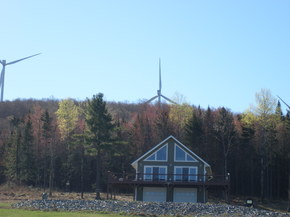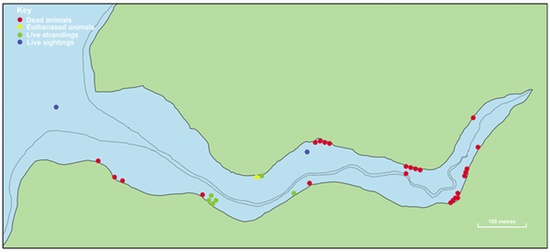AEI presents seminars to Sandia, NREL wind research teams
Human impacts, Science, Wind turbines 3 Comments »Earlier this month, I arranged to visit the wind research teams at Sandia National Lab and the National Renewable Energy Lab’s National Wind Technology Center, both of which are relatively nearby here in the southern Rockies. I’ve been following the work of many of these researchers for the past year or so—it was central to my 2012 Renewable Energy World conference paper and presentation on efforts to quiet turbines—and was very interested in learning more about their past, current, and future studies.

In particular, the Sandia team has recently built a Scaled Wind Farm Testing (SWiFT) facility, at which they’ll be studying wake interactions between turbines, and they’ve long been on the forefront of developing new materials and experimental active systems to reduce load strains caused by inflow turbulence. They’re also leading the development longer blades, which may have important noise implications. Their most exciting forward-looking project is a 5-year effort to re-activate development of vertical axis turbines, with the goal of moving toward 5-10MW scale vertical axis turbines for use offshore (this will be a 10-20 year project, if the first phase shows promise). Meanwhile, at NREL’s NWTC, lots of research has looked at the pinpointing the sources of sound on turbine blades, as well as advanced modeling of sound propagation in various atmospheric conditions. Researchers there have quantified the power-production trade-offs caused by wake interactions within wind farms, and are on the leading edge of new technology that might allow individual turbines to monitor incoming air flows and adapt their operations to minimize loads and noise. All of this research has intrigued me, because of the likely role of wakes and atmospheric turbulence in wind turbine noise levels, and in creating some of the more intrusive sound qualities that neighbors find hard to live with. My hope was to sit down with these researchers and learn more about their work, as well as draw on their experience to see whether they thought the turbulence factors they study to reduce stress on turbines may indeed also have an effect on the sounds.
As it turns out, they were also intrigued by such a dialogue, and both labs asked me to present their teams with a seminar on what I’ve been learning about community responses to turbine sound. Much of what I shared was new to them, and we had some great discussions. One of the central take-aways from both teams was that very little research has really looked at the acoustic effects of inflow turbulence, and there was universal agreement that this is an important area for future study (as a start, the SWiFT facility will incorporate some acoustic measurements). Many of them were especially interested in the varying sound quality of turbines, and the ways that this may trigger negative responses among neighbors; there was much speculation about the potential to identify the conditions that create the troublesome knocking, banging, thumping sounds, and perhaps adapt turbine operations to minimize or eliminate them. As I’ve long found in my interactions with academic and agency researchers, there was an easy openness and curiosity in both rooms, with many questions tossed around, and an excitement about studies they hadn’t seen before.
Read or download my presentation: The possible role of turbine, wake and shear effects on community response to wind farm noise (This is the “director’s cut,” including a few slides deleted for length from the final version, along with some additional slides from the REW conference presentation that cover related topics)
Community Response to Wind Farm Noise: The possible role of turbulence, shear, and wake effects by jimcummings

 In the first town-wide vote on the question of what to do about noise issues around two town-owned turbines, Falmouth voters overwhelmingly defeated a measure that would have authorized the Selectmen to continue on their preferred path of dismantling the turbines. The proposal carried a likely pricetag of about $800 per household, spread over ten years, largely to pay back loans and renewable energy credits that the town received in advance in order to buy and install the turbines. The measure fell by a 2-1 margin, with about 40% of the town’s registered voters turning out.
In the first town-wide vote on the question of what to do about noise issues around two town-owned turbines, Falmouth voters overwhelmingly defeated a measure that would have authorized the Selectmen to continue on their preferred path of dismantling the turbines. The proposal carried a likely pricetag of about $800 per household, spread over ten years, largely to pay back loans and renewable energy credits that the town received in advance in order to buy and install the turbines. The measure fell by a 2-1 margin, with about 40% of the town’s registered voters turning out. Since last fall, 105 formal complaints have been filed, by 23 different individuals living near the Sheffield, Lowell, or Georgia Mountain wind projects. Annette Smith of Vermonters for a Clean Environment is also collecting confidential complaints, some from people who have filed formal complaints, and some from neighbors who have felt it to be futile to complain to the turbine operators and/or state.
Since last fall, 105 formal complaints have been filed, by 23 different individuals living near the Sheffield, Lowell, or Georgia Mountain wind projects. Annette Smith of Vermonters for a Clean Environment is also collecting confidential complaints, some from people who have filed formal complaints, and some from neighbors who have felt it to be futile to complain to the turbine operators and/or state. 